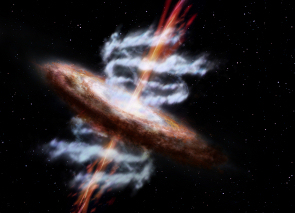ESA's new vision to study the invisible Universe
28 November 2013
The hot and energetic Universe and the search for elusive gravitational waves will be the focus of ESA's next two large science missions, it was announced today.
 |
| Artist's impression of a galaxy with outflows and jets. Credit: ESA/AOES Medialab |
Both topics will bridge fundamental astrophysics and cosmology themes by studying in detail the processes that are crucial to the large-scale evolution of the Universe and its underlying physics.
The science theme "the hot and energetic Universe" was selected for L2 – the second Large-class mission in ESA's Cosmic Vision science programme – and is expected to be pursued with an advanced X-ray observatory.
This mission, with a launch date foreseen for 2028, will address two key questions. How and why does ordinary matter assemble into the galaxies and galactic clusters that we see today, and how do black holes grow and influence their surroundings?
Black holes, which lurk unseen at the centres of almost all galaxies, are regarded as one of the keys to understanding galaxy formation and evolution.
The L3 mission will study the gravitational Universe, searching for ripples in the very fabric of space–time created by celestial objects with very strong gravity, such as pairs of merging black holes.
Predicted by Einstein's theory of general relativity but yet to be detected directly, gravitational waves promise to open a completely new window on the Universe.
Planned for launch in 2034, it will require the development of a spaceborne gravitational wave observatory, or extreme precision 'gravitometer', an ambitious enterprise that will push the boundaries of current technology.
"ESA has an outstanding record for developing state-of-the art space observatories that have revolutionised our knowledge of how stars and galaxies were born and evolved," says Alvaro Gimenez, ESA's Director of Science and Robotic Exploration.
"By pursuing these two new themes, we will continue to push back the scientific boundaries and unveil the mysteries of the invisible Universe."
The selection process for L2 and L3 began in March 2013, when ESA issued a call to the European science community to suggest the next scientific themes that should be pursued by the Cosmic Vision programme's Large missions.
Thirty-two proposals were received and assessed by a Senior Survey Committee, and following an extensive interaction with the scientific community two major themes were recommended to the Director of Science and Robotic Exploration.
"We had a difficult task in deciding which scientific themes to choose from all of the excellent candidates, but we believe that missions to study the hot, energetic Universe and gravitational waves will result in discoveries of the greatest importance to cosmology, astrophysics, and physics in general," says Catherine Cesarsky, chair of the Senior Survey Committee.
Although the launch dates for the L2 and L3 missions are more than a decade away, activities to prepare the missions will start very soon. Early in 2014, a call for L2 mission concepts will be announced to solicit proposals for a next-generation X-ray observatory. A similar procedure will be followed at a later date for the L3 mission.
"We have opened up a new scientific roadmap for Europe today that will establish our leadership in this field for the next two decades while we develop and implement new technologies for these exciting missions," adds Prof. Gimenez.
For further information, please contact
ESA Media Relations Office
Communication Department
Tel: + 33 1 53 69 72 99
Fax: + 33 1 53 69 76 90
Email: media![]() esa.int
esa.int

